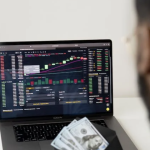As the world watches the dynamic shifts within global economies, the forex market remains an ever-evolving terrain of opportunities and challenges. In recent days, two major players, China and Russia, have taken decisive monetary policy actions that sent ripples through the financial landscape. With a keen eye on the latest developments, TrendFXNow brings you an insightful analysis of China’s surprising rate cuts and Russia’s emergency rate hike, offering a comprehensive overview of their potential implications on the forex market. Join us as we delve into the intricacies of these moves and explore their impact on the broader economic spectrum.
China’s Bold Rate Cut: A Move Amidst Uncertainty
The financial world was taken by surprise as China’s central bank unveiled an unexpected series of rate cuts. This bold maneuver comes in the wake of disappointing economic indicators, including weak July retail sales and industrial production that fell short of estimates. These numbers painted a picture of an economy grappling with challenges, raising concerns about the sustainability of growth and demand.
China’s monetary policy dance involved a range of cuts, including the Medium Term Lending Facility (MLF), 7-day Reserve Requirement Ratio (RRR), Overnight Standing Lending Facility (SLF), 7-day SLF, and 1-month SLF rates. The move reflects an attempt to stimulate the economy by encouraging borrowing and spending, ultimately aiming to offset the downward pressure.
Despite the rate cuts, a cloud of uncertainty lingers over the Chinese economic landscape. The Stats Bureau’s decision to halt reporting on the youth unemployment rate raises questions about transparency and accurate representation of labor market dynamics. As China navigates this intricate terrain, forex traders worldwide keep a watchful eye on the potential repercussions of these measures on currency valuations and trade dynamics.

Russia’s Emergency Rate Hike: Combating Currency Woes
Meanwhile, in Russia, a different scene unfolds as the central bank executes an emergency rate hike. The Bank of Russia’s decision to raise the 1-Week Auction Rate by a substantial 350 basis points to 12.0% aims to bolster the strength of the ruble. The currency’s depreciation had begun to exert inflationary pressures, adding an extra layer of complexity to the economic landscape.
The emergency rate hike underscores Russia’s determination to curb the potential inflationary spiral caused by the weakening ruble. The central bank’s focus on the currency’s impact on prices and the need to combat inflationary expectations highlights the delicate balance between exchange rates and domestic economic stability.
Forex traders are closely watching the ruble’s response to the rate hike, as the central bank’s actions may reverberate through global currency markets. Russia’s efforts to strengthen its currency and stabilize its economy provide valuable insights into the intricate relationship between monetary policy and forex dynamics.
Market Sentiments and Emerging Trends
Against the backdrop of these momentous monetary policy decisions, global financial markets respond with a mix of reactions. Asian markets exhibited a mixed performance, with the Hang Seng underperforming at -1.3%. In the European arena, indices saw declines ranging from -0.6% to -1.1%. US futures echoed this sentiment, ranging from -0.3% to -0.4%.
Gold and the Dollar Index (DXY) experienced slight fluctuations, with gold slipping by -0.3% and the Dollar Index inching down by -0.1%. In the realm of commodities, Brent crude oil and WTI oil saw marginal decreases of -0.1% and -0.2%, respectively. However, the TTF (Title Transfer Facility) gas index marked an impressive uptick of +5.9%. In the realm of cryptocurrencies, Bitcoin (BTC) remained relatively stable at 0.0%, while Ethereum (ETH) experienced a minor dip of -0.3%.
The intricacies of market sentiments and trends emphasize the delicate interplay between economic developments and forex dynamics. Traders worldwide are meticulously analyzing these shifts, seeking to capitalize on emerging opportunities and navigate the uncertainties that lie ahead.

Regional Insights: A Glimpse into Key Economic Players
Amidst the intricate dance of global forex, specific regions and nations emerge as pivotal players, offering valuable insights into economic trends and monetary policy strategies. Let’s take a closer look at some notable observations from various regions:
- Japan’s Q2 Preliminary GDP surprised analysts, showcasing a growth rate of 1.5% Q/Q and an annualized rate of 6.0% Q/Q. This positive performance reflects a significant improvement in economic conditions, shedding light on Japan’s trajectory amidst global economic challenges.
- Australia’s August Reserve Bank of Australia (RBA) Minutes reveal a path back to the inflation target, with cash rates maintained at the current 4.10%. The RBA’s commitment to a credible strategy reflects its determination to navigate the delicate balance between inflation and economic growth.
- The United Kingdom witnesses a complex interplay of job data, with higher unemployment and wages. This intricate dynamic contributes to the fluctuating landscape of gilts and sterling, underscoring the nuanced factors influencing currency valuations.
Conclusion
In the ever-evolving world of forex, the recent rate cut by China and the emergency rate hike by Russia have injected a fresh wave of complexity into global financial markets. As traders and investors grapple with the implications of these moves, the forex landscape remains a dynamic arena ripe with opportunities and risks.
At TrendFXNow, our commitment to providing comprehensive insights and analysis empowers you to navigate the intricate world of forex trading. Stay informed, stay engaged, and embark on a journey of understanding as we unravel the nuances of these monetary policy decisions and their far-reaching impact on the forex market. For the latest updates and expert insights, visit TrendFXNow at trendfxnow.com.




